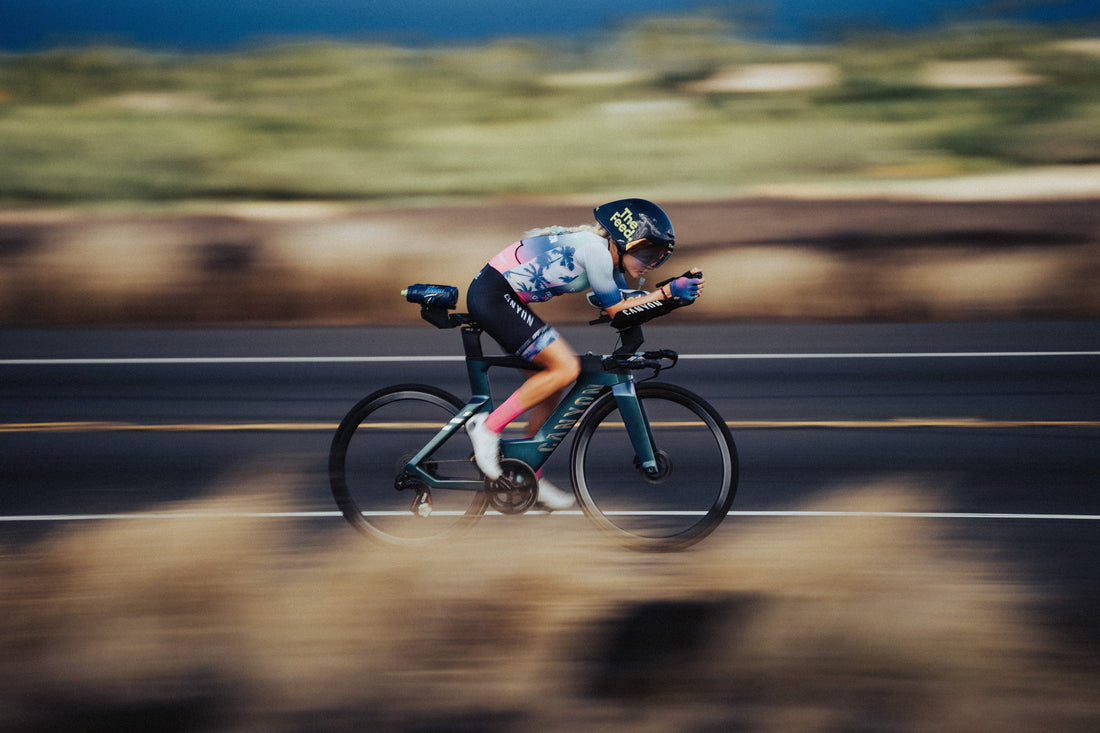
Triathlon Bike vs. Road Bike: Which One Should You Choose?
Share
It’s a question nearly every up-and-coming triathlete asks at some point: Should I ride a triathlon bike or stick with a road bike? The answer isn’t always straightforward. Understanding the differences between these two bike types is crucial. Let’s break it down.
Contents
• What's the Purpose of Each Bike Type?
• Triathlon vs Road Bikes: Key Design Differences
• Triathlon vs Road Bike Frames
• Aero Bars vs Handlebars
• Component Comparison: Wheels, Gearing, and Brakes
• Road Bikes: A Great Starting Point for Beginner Triathletes
• When to Upgrade to a Triathlon Bike
• How to Decide: Road Bike or Tri Bike?
What’s the Purpose of Each Bike Type?
A triathlon bike is a close cousin of the time trial bike and is designed with a one goal: maximize speed. From aggressive frame geometry to integrated storage and wind-cutting tube shapes, every detail is optimized for aerodynamics. That is the reason why Canyon developers spend hours in wind tunnels refining every curve.
On the flip side, a road bike offers versatility. It’s easier to handle, more comfortable for long rides, and better suited for climbing. While not as aerodynamically aggressive, road bikes still deliver impressive speed – especially in group rides or training scenarios.
Triathlon vs Road Bikes: Key Design Differences
When comparing these two bikes, it’s all about how they’re built and how that impacts your ride.
Triathlon vs Road Bike Frames
The geometry of a triathlon bike differs significantly from a normal road bike. The steeper seat tube angle positions you forward, almost over the bottom bracket. This position engages your quads more and gives your hamstrings a bit of a break – critical when there’s a run waiting after the bike leg. However, this forward position changes your center of gravity, making descents and sharp turns a bit trickier compared to a road bike.
Aerodynamic frames like our Speedmax come with angular tubes, internal cable routing, and built-in storage – all to minimize drag.
Aero Bars vs Handlebars
Road bikes are equipped with drop handlebars, allowing riders to choose between a relaxed position on the tops or a more aggressive posture in the drops. This flexibility improves bike handling but increases drag.
Triathlon bikes use aero bars. These aero bars pull you into a narrow, forward-leaning body position, but they also allow you to slice through the wind. While this isn’t always the most comfortable position over long distances, but the Speedmax’ has 110 mm of adjustability. This helps to dial in your bike fit to improve comfort. There’s one trade-off for the improved aerodynamics: The brake levers aren’t accessible in the aero position, you will need to move your hands to the base bar.
Improve your aerodynamics on a triathlon bike
Component Comparison: Wheels, Gearing, and Brakes
At similar price points, road and tri bikes share comparable gearing and brake systems. However, tri bikes often come with aero-optimized components. For instance, deep-section wheels are built to cut through the wind, although they can be twitchy in crosswinds – something you don’t typically encounter on a standard road bike.
Road Bikes: A Great Starting Point for Beginner Triathletes
Many beginners jump into their first triathlon on a bike they already own – which is often a road bike. And that’s perfectly okay. Look around a sprint triathlon’s transition area, and you’ll find plenty of road bikes.
If you’re just starting with cycling, consider getting a road bike. It is easier to manage, more forgiving, and better for developing basic cycling skills. Plus, if you pick something like the Canyon Aeroad, you can benefit from some aerodynamic features (and even add aero extensions!) while maintaining everyday rideability.
Enjoy the maneuverability and group rides on a road bike. 
When to Upgrade to a Triathlon Bike
As your goals evolve, your equipment may need to as well. If you’re looking to shave minutes off your bike split, a triathlon bike could be a game-changer.
Research from Global Triathlon Network shows that riding a triathlon bike at 30 kph can save you between 37–49 watts compared to a road bike. Bump that speed up to 45 kph, and the savings jump to 114–150 watts. That’s free speed without extra effort – just better positioning and a more aero frame.
How to Decide: Road Bike or Tri Bike?
If you’re lucky enough to have the budget and space, owning both bikes gives you maximum flexibility. But for most, it’s a matter of picking the right tool for your priorities.
Stick With a Road Bike If:
- You’re doing triathlons occasionally and aren’t chasing podiums.
- Group rides and scenic climbs are your idea of a good time.
- You only have room or budget for one bike.
- You prefer technical or hilly terrain.
Go for a Triathlon Bike If:
- Triathlon is your main focus, and you’re racing regularly.
- You’re aiming to improve your bike split.
- You plan to invest in a professional bike fit to maximize comfort and power after your bike purchase.
As many tri bike riders will tell you, a tri bike isn’t essential – but once you make the switch, you’ll notice the difference. Faster splits, more comfortable aero positioning, and a machine built specifically for race day.
Unboxing your new Speedmax is more than a gear upgrade – it’s a commitment to chasing goals, pushing limits, and unlocking your full potential on the course. The right bike can make the journey smoother – and faster!
Only one way to find out.
All images on this page are copyrighted by Canyon Bicycles.
